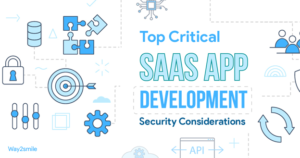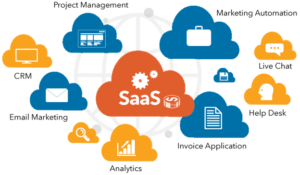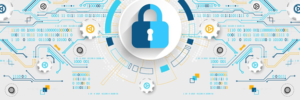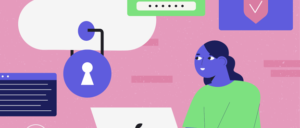Introduction
Today, one may notice an increasing trend of adopting SaaS development solutions in the digital realm. Gartner’s research report has shown that by 2022, SaaS market revenue is expected to grow to $143.7 billion, proving that cloud services are accepted in most industries. The SaaS usage trend is expanding, and many security challenges commence as it does. Based on McAfee research, 99% of the configuration errors seen in the cloud are to be corrected. A significant security gap can be detected. Moreover, using IBM’s 2020 Cost of a Data Breach Report, the details of the data breaches in 2020 suggest the average data breach cost to be about $3.86 million.
SaaS development services security is not all about protecting software but also involves how the data it is processing and storing is protected. The strictness of the rules, like the GDPR (General Data Protection Regulation) in Europe and the CCPA (California Consumer Privacy Act) in the USA, makes observing rules and security factors decisive for the design of SaaS products.

Source: Citrusbug
Discovering SaaS Security Meaning
With SaaS solutions, the arena of the business working process became limitless, providing scalability, flexibility, and cost-effectiveness. Despite this, the fact that going for SaaS has its own security risk makes these technologies insufficient. It, therefore, demands that security measures be developed. A mess in space and on the ground would lead to the SaaS application losing lots of money, damaging its reputation, and exposing itself to legal liabilities.
In this regard, understanding the value of SaaS security is the crucial first step toward developing an application that is secure by design. Security involved practically the app layer that involved the application data. The GDPR and the CCPA have data protection standards with vital requirements that organizations must follow; hence, compliance with the regulations is critical to BaaS security.
Key Security Challenges in SaaS Development
SaaS applications face complicated security challenges requiring developers to make out security management solutions. These challenges include:
- Data breaches: The most considerable risk of SaaS applications is that one may suffer from a security breach. Because SaaS software generally serves as a platform for handling large volumes of private data, these constitute a particular danger as a valuable asset to cyber criminals.
- Identity and access management: Users’ authorization, as well as access to the application and its data from various devices and locations, is one of the most challenging parts, considering the enormous device population. This problem is further exacerbated by the growing number of devices users may use to access the SaaS application.
- Multi-tenancy: Many contemporary SaaS applications are multi-tenant and, as a result, serve and support the needs of multiple customers at one time through shared resources. Providing a secure isolation environment for tenants’ data is fundamental to recording the tenants’ data securely and preventing data breaches between tenants.
- Compliance: SaaS programs ought to fulfil the suite of industry standards and regulations, which may understandably differ in various locations and sectors, as if not the customers who own them.
Best Practices for Securing SaaS Applications
To mitigate the security risks associated with SaaS applications, developers should follow these best practices: To mitigate the security risks associated with SaaS applications, developers should follow these best practices:

Source: Citrusbug
Enforce Strong Authentication and Authorization Mechanisms
Implementing the mechanisms against strong authentications, standing foremost among those measures, which often is multi-factor authentication (MFA), dramatically increases the protection against unfair entry to resources. Additionally, using fine-grained authorization controls ensures that each user can access only the data and functionalities pertinent to their role.
Secure Data Storage and Transmission.
Data encryption at rest and in transit is critical in inhibiting data leakage and hacking. Thus, securely organizing your data is critical. Protective technical measures include adopting secure protocols like TLS for data transmission and employing encryption algorithms for data stored in databases and file systems.
Continuous Security Testing and Audit
A consistent security program, which involves penetration testing, code reviews, and automated security scans at regular durations to detect and fix security holes before they are exploited, is a solution that can be applied. This could be further reinforced by performing security audits that guarantee meeting regulatory requirements and standards.
Implementing Security Headers and Content Security Policy.
Last but not least, to mitigate risks of common web vulnerabilities, cross-site scripting (XSS) and clickjacking, server-side security headers, and content-security policies (CSP) are of exceptional importance. Thus, an ability to implement such mechanisms enables blocking specific resources that a client can download and execute so that remote exploitation on the client’s part is prevented.
Monitor and React to Security Incidents
Following an unceasing process of SaaS applications for malicious activities is an essential element of quick detection for any potential future cases of security mishaps. A plan for the response to the incident aims to reduce the reaction time and allows the team to handle adversity in the event of any security breach.
Data Privacy and Compliance
The cross-cutting factors of data privacy awareness and the harsh criteria of data protection regulations should be considered, as SaaS solutions should be developed with privacy in mind. In this respect, we will ensure that data minimization principles are implemented, that consent is obtained from the users where required, and that users can control their data. Alongside, providers should uncover their data processing activities and guarantee their privacy policy.
Besides being a legal requirement, complying with recognized standards and regulations might help customers understand that the software is trustworthy and secure. It does not matter whether GDPR, HIPAA, SOC 2, or any other standard SaaS applications have to meet compliance with these directly from the inception level.

Source: Citrusbug
Cloud Security Architecture and Isolation
Developing a secure cloud architecture is essential for the security of SaaS applications. Here, picking the appropriate cloud service type (IaaS, PaaS, SaaS) and securely configuring the cloud environment follows. Enforcing proper isolation of cloud components and tenants is a core element of cloud security architecture. Tasks like the containerization and VPC (Virtual Private Cloud) application may help minimize lateral movement during an infection.
Incident Management and Recovery
Security incidents can slip through all preventive measures we take. Having a fit-for-purpose emergency response and recovery plan is necessary to make things easy while dealing with security incidents and overcoming them. The program needs to have incident detection, response, communication, and post-incident analysis action plans to avoid the recurrence of the same events. Periodical test runs for the incident response plan with the drills and scenario simulations will permit the team to act effectively when confronted with real-life incidents.
Continuous Security and Monitoring
Dynamic cloud environments alongside SaaS applications require consistent security monitoring and the versioning of security posture now and then. The real-time detection of security threats and anomalies enables an adaptive, continuous monitoring strategy. Tools or services that allow access to insightful use of applications and infrastructure, such as cloud access security brokers (CASBs) and security information and event management (SIEM) systems, are the most effective ones for gaining cloud control.

Source: Citrusbug
DevSecOps Integration
The notion of DevSecOps, which stems from the security integration into the DevOps process, underlines the great importance of security within the reliable, high-speed delivery environment typical of SaaS applications. This approach entails making security aspects part of CI/CD pipelines. Thus, security concerns are continually addressed in CI/CD pipelines. Automation occupies a significant position in DevSecOps as automated security scans and compliance checks are integrated into the building process. Teams can gain early detection and remediation of security issues just by enforcing a secure CI/CD pipeline. They, in turn, ensure that their production environments stay secure and free from vulnerabilities.
Scalable Security for SaaS
With a growing number of SaaS applications, cybersecurity solutions must also expand to operate effectively. Scalable security mechanisms are an essential aspect of systems that can handle growing amounts of traffic or data without degrading their performance or the quality of the user experience. This encompasses scalable encryption, identity management solutions, and access controls that will dynamically shift with the number of users and the application architecture. It can be achieved by using cloud-native services such as auto-scaling and managed database services that are around to keep higher security standards.
User Education and Awareness
Besides the technical methods, which are an integral part of the security system, the human factor of security safety should be addressed. Training the users about safe procedures, potential risks, and how they should work with the SaaS application is pivotal for instilling security. It could comprise teaching how to recognize phishing attempts, appreciating the necessity of strong passwords, and adopt multi-factor authentication (MFA). SaaS suppliers must give the tool users straightforward tips and resources to ensure their data protection and safe application provision.
Conclusion
Protecting SaaS apps is complex and cumbersome and requires complete and dynamic security measures. Features like robust cloud security and security within development cycles, scalability, educating users, and fostering a security mindset are complementary to stopping current breaches. By taking such measures, SaaS providers will not only strengthen their safety position but also gain the trust of their customers, reducing the risk of failure and creating a competitive edge in the digital marketplace. With advancing technology, so will security processes. Therefore, it will be crucial to stay up-to-date and ahead if the safety applications are to be secured.
About Author

Ishan Vyas is one of the founders of Citrusbug and a seasoned technical content writer with over 10 years of experience in the industry. With a passion for technology and a knack for translating complex concepts into accessible content, Ishan has been instrumental in helping readers understand and navigate the ever-evolving world of Software Development. You can connect with him on Linkedin.





